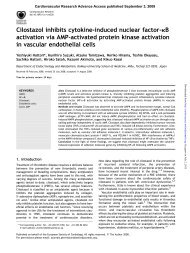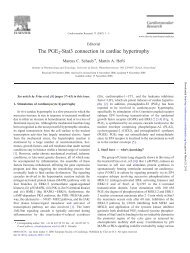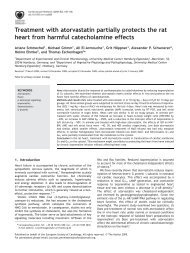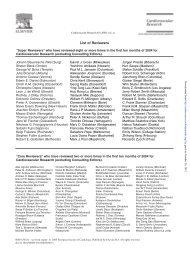FGF-16 is a target for adrenergic stimulation through NF-kB ...
FGF-16 is a target for adrenergic stimulation through NF-kB ...
FGF-16 is a target for adrenergic stimulation through NF-kB ...
Create successful ePaper yourself
Turn your PDF publications into a flip-book with our unique Google optimized e-Paper software.
<strong>FGF</strong>-<strong>16</strong> <strong>is</strong> a <strong>target</strong> <strong>for</strong> <strong>NF</strong>-<strong>kB</strong> activation 109<br />
support IsP responsiveness in conjunction with, it appears, the adjacent<br />
<strong>NF</strong>-<strong>kB</strong> element at 2375/2367. Th<strong>is</strong> element alone showed significant<br />
association with both <strong>NF</strong>-<strong>kB</strong> p50 and p65 subunits in mouse<br />
heart chromatin in situ; a heterodimeric complex of these subunits <strong>is</strong><br />
the most common and associated with transcriptional activation.<br />
Finally, th<strong>is</strong> downstream putative promoter region, including both<br />
TATA1 and proximal <strong>NF</strong>-<strong>kB</strong> elements, are conserved in the human<br />
genome and <strong>is</strong> responsive to b-<strong>adrenergic</strong> <strong>stimulation</strong> after gene<br />
transfer, further indicating that the proximal <strong>NF</strong>-<strong>kB</strong> site in both the<br />
human and mouse Fgf-<strong>16</strong> genes <strong>is</strong> sufficient to confer IsP<br />
responsiveness.<br />
Our previous analys<strong>is</strong> of the murine <strong>FGF</strong>-<strong>16</strong> 50-flanking region<br />
suggested cardiac-specific control via an upstream promoter region<br />
containing the TATA2 sequence 50-TGTAAA-30 at nucleotides<br />
21126/21121 but not TATA1 sequences, and was dependent on<br />
the binding of MEF-2. 6 Our present analys<strong>is</strong> of the human Fgf-<strong>16</strong><br />
gene and flanking sequences did not reveal an analogous promoter<br />
region or, indeed, the MEF-2 site, although other putative MEF-2<br />
sites can be found elsewhere in the human sequences. Instead, the<br />
downstream sequences containing TATA1 was highly conserved<br />
between the human and mouse genes, as was the most proximal<br />
<strong>NF</strong>-<strong>kB</strong> binding site. Although the 2735/21 h<strong>FGF</strong>-<strong>16</strong>p.luc was not<br />
expressed efficiently, th<strong>is</strong> downstream promoter region of both the<br />
mouse (2747/212) and human (2735/21) Fgf-<strong>16</strong> genes were<br />
increased significantly above background levels in response to <strong>adrenergic</strong>/IsP<br />
<strong>stimulation</strong> in a PDTC/PS-1145-sensitive manner in transfected<br />
cardiomyocytes. Although there <strong>is</strong> strong evidence <strong>for</strong><br />
2 – 5<br />
<strong>FGF</strong>-<strong>16</strong> RNA expression in the postnatal rodent myocardium,<br />
similar data to support expression in the human heart have been<br />
lacking. For example, although <strong>FGF</strong>-<strong>16</strong> RNA was observed in<br />
samples of human aorta, left atrium, and ventricle, there was a<br />
failure in the same study to detect human <strong>FGF</strong>-<strong>16</strong> RNA in ‘adult<br />
heart’ or ‘foetal heart’. 19 Our assessment of three independent<br />
RNA sources indicates a low level of Fgf-<strong>16</strong> gene expression in the<br />
adult human heart, which <strong>is</strong> cons<strong>is</strong>tent with our promoter analys<strong>is</strong>.<br />
By extension, however, the promoter could be stimulated and thus<br />
relative <strong>FGF</strong>-<strong>16</strong> expression may increase under certain conditions.<br />
Furthermore, the detection of amplifiable transcript corresponding<br />
to sequences downstream but not upstream of the TATA sequence,<br />
identified on the bas<strong>is</strong> of similarity to TATA1 in the mouse, <strong>is</strong> cons<strong>is</strong>tent<br />
with the use of a conserved promoter region. However, the<br />
absence of TATA2 (and previously identified MEF-2) 6 sequences in<br />
the human Fgf-<strong>16</strong> gene indicates that while some expression and regulation<br />
(presumably via TATA1) will be conserved, mouse and human<br />
patterns of <strong>FGF</strong>-<strong>16</strong> gene expression may not be identical. Th<strong>is</strong> would<br />
account <strong>for</strong> the apparent more readily detectable levels of <strong>FGF</strong>-<strong>16</strong><br />
RNA in rodent vs. human heart samples. In addition, TATA1 as<br />
opposed to TATA2 <strong>is</strong> likely to also play a role in <strong>FGF</strong>-<strong>16</strong> expression<br />
outside the heart. Cons<strong>is</strong>tent with th<strong>is</strong> expectation, both 2747/212<br />
m<strong>FGF</strong>-<strong>16</strong>p.luc and 2735/21 h<strong>FGF</strong>-<strong>16</strong>p.luc genes are expressed<br />
at low levels in rat glial (C6) and skeletal myoblast (C2C12) cell<br />
lines after gene transfer (data not shown). Thus, although we<br />
cannot conclude that <strong>FGF</strong>-<strong>16</strong> levels are regulated by <strong>adrenergic</strong><br />
<strong>stimulation</strong> (or T<strong>NF</strong>-a) in the human heart or that th<strong>is</strong><br />
production would be cardiac specific, the RNA expression and<br />
transfection data strongly support a role <strong>for</strong> <strong>FGF</strong>-<strong>16</strong> production at<br />
th<strong>is</strong> site.<br />
The association of <strong>NF</strong>-<strong>kB</strong>-related subunits p50 and p65 with an<br />
apparently conserved <strong>NF</strong>-<strong>kB</strong> DNA element immediately upstream<br />
of TATA1 in situ, and requirement of these sequences <strong>for</strong> significant<br />
promoter activity <strong>is</strong> cons<strong>is</strong>tent with a role <strong>for</strong> <strong>FGF</strong>-<strong>16</strong> production in<br />
the mouse heart and involvement of <strong>NF</strong>-<strong>kB</strong> activation. <strong>NF</strong>-<strong>kB</strong> cellular<br />
availability increases after IsP treatment, 20 – 22 and the sensitivity of the<br />
Fgf-<strong>16</strong> IsP response to PDTC and PS-1145 indicates the involvement<br />
of <strong>NF</strong>-<strong>kB</strong> activation. At first glance, the decrease in the association of<br />
<strong>NF</strong>-<strong>kB</strong> subunits at 2375/2367 suggested by ChIP analys<strong>is</strong> appears<br />
incons<strong>is</strong>tent with the increase in <strong>FGF</strong>-<strong>16</strong> RNA levels and promoter<br />
activity at 2 h. However, assessments of RNA and reporter gene<br />
activity are measurements of accumulation and as such consequences<br />
of IsP treatment. Thus, while together they suggest that the effect <strong>is</strong>, at<br />
least in part, transcriptional, the pattern of transcription over the 2 h<br />
of treatment <strong>through</strong> th<strong>is</strong> assessment <strong>is</strong> not known. Although accumulation<br />
may reflect a steady increase in RNA levels over the 2 h, it <strong>is</strong><br />
also possible that an initial spike of activity occurred in the first<br />
30 min of treatment followed by a decrease to basal levels (or<br />
lower), perhaps due to the expected loss of IsP effectiveness as a<br />
drug; in the dog IsP has been reported to peak 5–15 min after admin<strong>is</strong>tration.<br />
23 In a similar manner, the apparent decrease in the levels of<br />
<strong>NF</strong>-<strong>kB</strong> association does not rule out increases during the 2 h of IsP<br />
treatment. In terms of binding seen in the absence of IsP <strong>stimulation</strong>,<br />
it <strong>is</strong> possible that procedures involved in handling mice and t<strong>is</strong>sue <strong>is</strong>olation<br />
induce sufficient stress to stimulate <strong>NF</strong>-<strong>kB</strong> activity. Even in the<br />
case of IsP treatment, signs of admin<strong>is</strong>tration are reported in the first<br />
minute. IsP treatment presumably results in a level or duration of<br />
<strong>stimulation</strong> beyond these ‘background’ levels as reflected by the significant<br />
PDTC/PS-1145 sensitive increase in m<strong>FGF</strong>-<strong>16</strong> RNA levels<br />
observed at 2 h. However, although our data support a p50–p65<br />
association with the <strong>NF</strong>-<strong>kB</strong> site at 2375/2367 in vivo, we cannot<br />
rule out a contribution from alternative mechan<strong>is</strong>ms. It <strong>is</strong> possible<br />
that p50, which appears to associate with multiple sites, can also interact<br />
with other <strong>NF</strong>-<strong>kB</strong> subunits (e.g. c-Rel or RelB) or even as a homodimer.<br />
The p50 subunit, like p52, lacks a trans-activation domain, and<br />
p50/p50 homodimers can function as transcriptional repressors, as<br />
they able to bind competitively to <strong>kB</strong> sites, thereby preventing heterodimer<br />
binding and trans-activation. 7,8 <strong>NF</strong>-<strong>kB</strong> has also been linked<br />
with gene repression under certain circumstances, ra<strong>is</strong>ing the possibility<br />
of a mechan<strong>is</strong>m of derepression contributing to the response<br />
observed. 7,11,24<br />
As indicated, <strong>NF</strong>-<strong>kB</strong> <strong>is</strong> associated with several cardiac pathologies.<br />
7,11 Thus, the possibility that <strong>FGF</strong>-<strong>16</strong> RNA expression <strong>is</strong> a<br />
<strong>NF</strong>-<strong>kB</strong> <strong>target</strong> <strong>is</strong> intriguing. The relevance of a transient increase in<br />
<strong>FGF</strong>-<strong>16</strong> via b-<strong>adrenergic</strong> <strong>stimulation</strong> may lie in its ability to alter the<br />
threshold level of activity <strong>for</strong> other key signalling factors, either<br />
<strong>through</strong> simple receptor competition and/or <strong>through</strong> cross-talk and<br />
modification of the downstream signalling environment. Such action<br />
could conceivably be perm<strong>is</strong>sive or restrictive to the action of<br />
other factors. Previously, we showed that <strong>FGF</strong>-<strong>16</strong> applied to neonatal<br />
cardiomyocytes could compete with <strong>FGF</strong>-2 <strong>for</strong> the occupation of <strong>FGF</strong><br />
receptors; in addition, we observed potential cross-talk with IGF-1<br />
receptor. 5 In both cases, <strong>FGF</strong>-<strong>16</strong> interfered with growth factor activity<br />
<strong>through</strong> the downstream signalling modulator protein kinase C. The<br />
ability of <strong>FGF</strong>-<strong>16</strong> to alter the effects of other growth factors,<br />
perhaps even contributing to setting threshold levels on processes<br />
such as stress/inflammatory response, cell survival, and/or<br />
hypertrophy. The study of these pathophysiological processes in<br />
mice lacking a functional Fgf-<strong>16</strong> gene may be an important step<br />
towards understanding the function of th<strong>is</strong> evolutionarily conserved<br />
growth factor.<br />
Downloaded from<br />
http://cardiovascres.ox<strong>for</strong>djournals.org/ by guest on January 5, 2013









